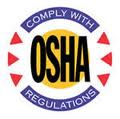The big industrial hygiene conference (AIHCe) is held in a different city each year. This year was Indy, Indiana. Below is my personal top ten list  of “lessons learned” from last week.
- IH’s need to do a better job of sharing. We don’t share data, experiences, information, knowledge or our ideas well.
- CPWR is trying to share. Center for Construction Research & Training. Â I’m looking forward to seeing their published independent review of local exhaust ventilation (LEV) units.
- The minimum exhaust rate for a portable exhaust unit must be 106 cfm (cubic feet per min) to capture particulates (dust, silica) during tuckpointing with a 5 in grinder (but it’s also a good rule of thumb).
- Asphalt milling machines are still a huge silica problem. Water controls are NOT enough. You need a local exhaust system too. (here’s an earlier post I made on it)
- GHS Safety Data Sheets – it’s not as complicated as you think. There are some significant changes, but don’t worry, OSHA’s here to help (ha). Seriously, more information will be available soon.
- Ignite. Have you seen these before? Short, stand up speeches about their ideas/passions. Similar to TED. Some were better than others. But, did I mention they were short?
- Committees. Be careful when you open your mouth. My idea was so great, they are making me do it.
- Â ANSI A10.49! A health standard for construction. Great idea, but lots of work.
- Check out Environment for Children. I don’t know much about it, but they have a great mission.  Believe me, in the US, we’re WAY ahead.
- Presentation. It’s all up to you to make it. I will not cast blame on those who had bad presentations. BUT, it reminds me that I should work on this skill. Even if you have something good to say, if you give a horrible presentation, it’s likely no one will notice. On the other side, if your presentation is good, people will listen, even if you’re talking about nothing! Â My favorite of the week: Dr. Mike Morgan (Univ. of Washington) on Chromium VI. He was very factual, not too flashy, and make the point without needless details.

